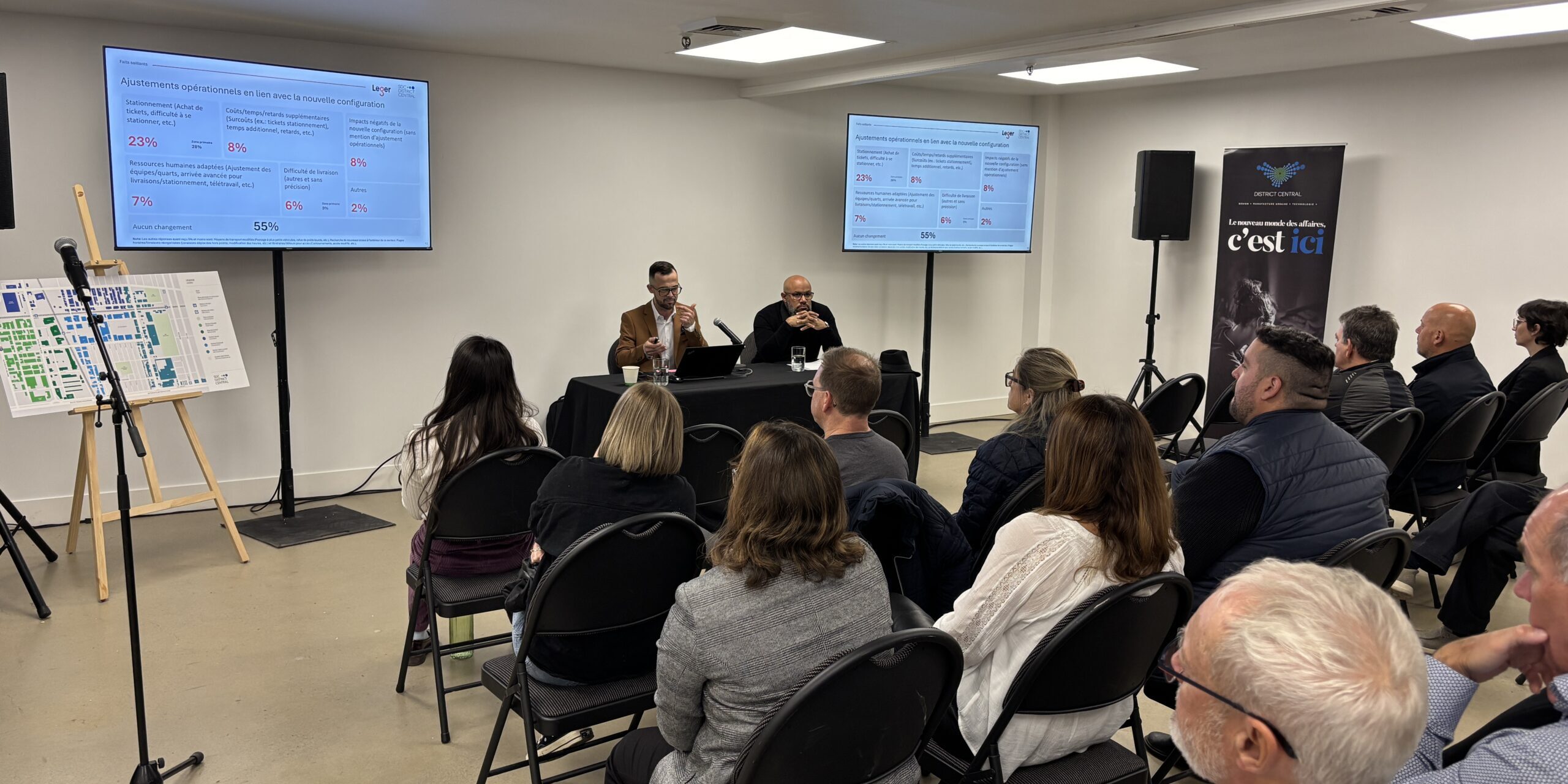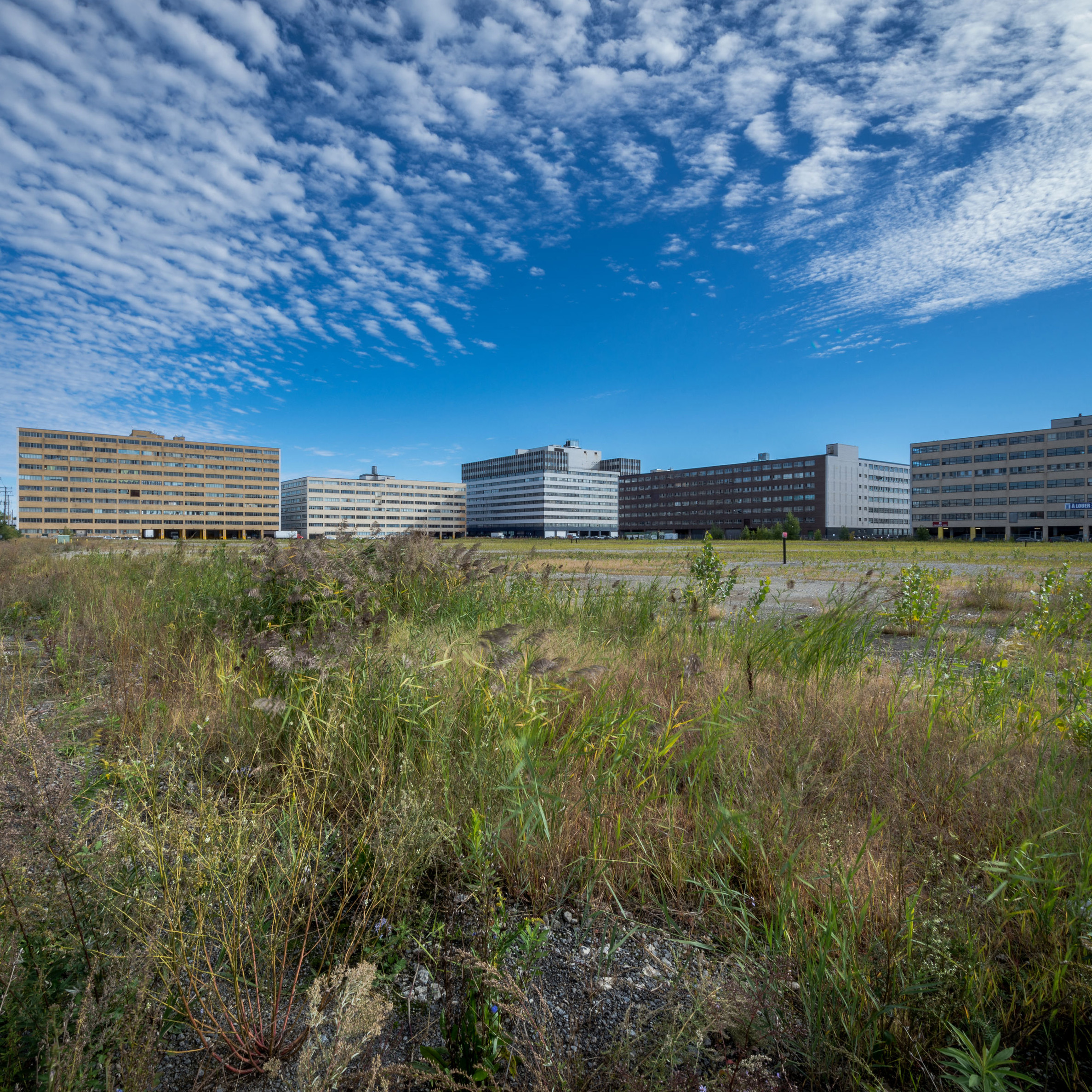NEWS FROM RIGHT HERE
North-South Bike Path: A Léger Survey Confirms Significant Impacts on the District Central
Over the past year, concerning testimonies have multiplied regarding the first segment of the North-South bike path implemented in the District Central. A Léger survey conducted at the end of summer 2025 confirms that the impacts on the territory’s daily life are far from anecdotal. Logistical and safety issues, economic and environmental setbacks—many local entrepreneurs are facing major challenges.

Unveiling of the survey results by Guillaume Gingras, Director of Research at Léger – October 15, 2025
Due to the loss of 339 parking spaces—just along the bike path route—and additional spaces removed in surrounding areas in recent years, accessibility impacts are particularly severe. The vast majority of businesses report difficulties accessing their facilities for employees (87%), clients (91%), and suppliers (95%), as well as nearby parking (96%).
“With the arrival of the bike path,” explains Prosper Azoulay, owner of Printex Canada, located on Chabanel St. W. at the corner of Meilleur, “all the parking spaces in front of our business were eliminated. Delivery drivers are now forced to double-park and risk fines. It’s the same for our clients. Our business regularly receives deliveries of four-by-eight-foot panels. Carrying panels or boxes by hand to a parking spot two blocks away is a major inconvenience. To compensate, we personally transport materials to our clients’ vehicles. Despite this, we’re losing customers.”
Declining Competitiveness and Profitability
Azoulay’s situation is not unique. Among survey respondents, 66% believe their company’s competitiveness has declined since the bike path was implemented. A similar proportion (65%) report increased operating and production costs. Furthermore, 7 out of 10 business owners (71%) say their medium- and long-term planning capacity has been affected.
Philippe Gagnon, Director of Canadian Operations at Attraction, estimates the additional costs for his company at around $15,000 per year.
“Since the bike path was introduced, the transport companies we work with refuse to send large trucks to our location because they can no longer park safely and are accumulating fines. Both raw materials and finished products are now transported using smaller trucks to and from a distribution center in Lachine, where the large trucks we used to rely on can still operate easily. That’s where final shipments to clients are made and raw materials are received.”
Operational pressure has intensified, especially since the bike path’s deployment coincided with one of the largest contracts in the company’s history, making any production slowdown unthinkable.
“The route came as a surprise, and we had to make emergency agreements, which reduced our negotiating power. For a small business like ours, with very slim profit margins, the added costs are a real problem.”
A Setback in Sustainable Development
The newly added transshipment step also negatively affects the company’s carbon footprint.
“Attraction is a carbon-neutral company. We offset the GHGs produced by certain operations. Transshipment increases the number of trucks on the road, so even with equal production, GHG emissions rise. It’s not only costly and logistically complex, but also harmful to the environment,” summarizes Gagnon.
Ultimately, the company may reconsider its presence in the area.
“We chose the District Central four years ago for its ecosystem. Many of our suppliers and partners are within a 1.5-kilometer radius. From a sustainability standpoint, it’s fantastic and aligns with our company’s values. It’s one of the neighborhood’s strengths, but there may come a time when that’s no longer enough to maintain operations here.”
The sense of safety in the area has also significantly declined. A majority of survey respondents (69%) feel the District has become less safe, with more than half (56%) reporting a major drop in their sense of security.
Prosper Azoulay of Printex Canada isn’t surprised by these figures.
“Because the parking in front of our business was removed, I personally witnessed an emergency vehicle unable to move forward because a double-parked delivery truck was blocking traffic. Someone, somewhere, suffered the consequences—and that can affect the overall sense of safety.”
This sentiment is echoed by Alec Veilleux, President of Groupe Trium, who has been in the area for 25 years.
“About fifteen trucks make deliveries to us daily. Drivers are now so afraid of hitting someone that they refuse to park without a spotter. Even the signage installed to mitigate the inconvenience causes confusion. It’s only a matter of time before a serious accident occurs. We’re not against bike paths—far from it—but better planning was needed. This is an industrial zone, and that wasn’t taken into account.”
A Lack of Planning
The failure to consider the industrial nature of the area and the lack of planning were criticized by many survey respondents (80%). Nearly as many entrepreneurs (85%) believe the logistical impacts of the bike path route were not considered. About nine out of ten also feel they were not adequately consulted.
Even those who didn’t have to adjust their operations fear a weakening of the territory’s social and economic fabric.
Gabriel Tupula, Founder and CEO of IT firm Big Bang, is among them.
“Safety and accessibility issues affect everyone. At a time when we’re trying to encourage people to return to the office, this is far from ideal. The same goes for clients. To be honest, we’re less inclined to invite them to our location, regardless of their mode of transport. That’s fewer people frequenting local businesses. Without being alarmist, the domino effect could be huge. After all the efforts made to revitalize the area, it’s disheartening.”
Sidebar: Robust Results
Conducted between mid-August and mid-September 2025, the survey reached 170 businesses, including 120 located along the bike path route. The overall response rate was 16.2%, exceeding 35% among entrepreneurs directly impacted by the new infrastructure. According to Guillaume Gingras, Director of Research at Léger, these figures ensure the reliability of the results. “For this type of initiative,” he says, “response rates typically range from 3% to 10%, with an average of around 6%. The rate obtained here can therefore be considered very strong, especially in the primary zone—the industrial and logistical heart of the District Central.”
Strengthening Ties Through Mutualization
On the initiative of the SDC and Communautique, several businesses in the District Central came together at Maison Marie Saint...
Lire la suiteAn Immense Vacant Lot With Great Potential Is Stirring Up Strong Feelings
Resting in the hands of the Ville de Montréal, the future of the vacant lot in the Chabanel sector of...
Lire la suiteThe Unveiling of the Mural dedicated to Iona Monahan: A First for Jacques Lebleu
Thursay, September 20, 2018 marked a milestone for the District Central. This fall day was a unique opportunity to pay...
Lire la suite


